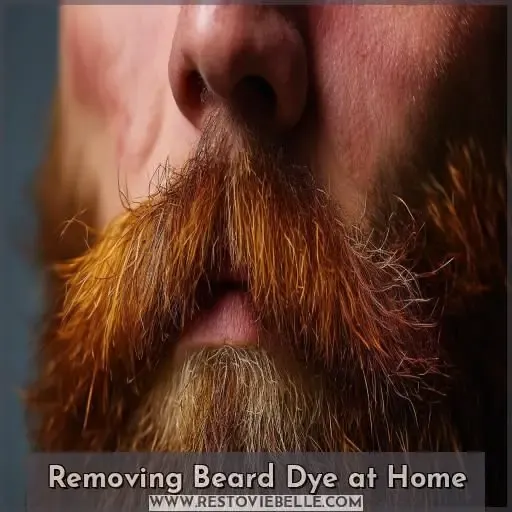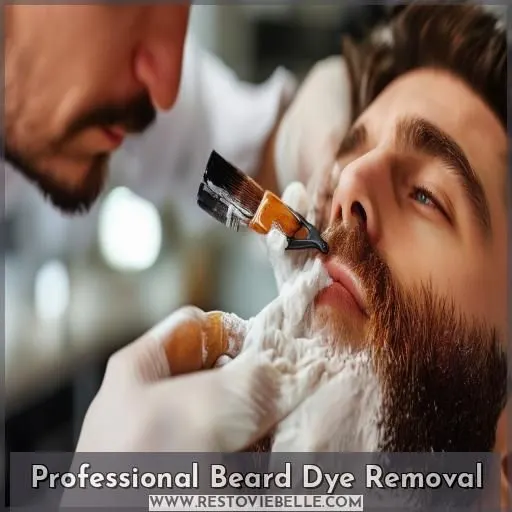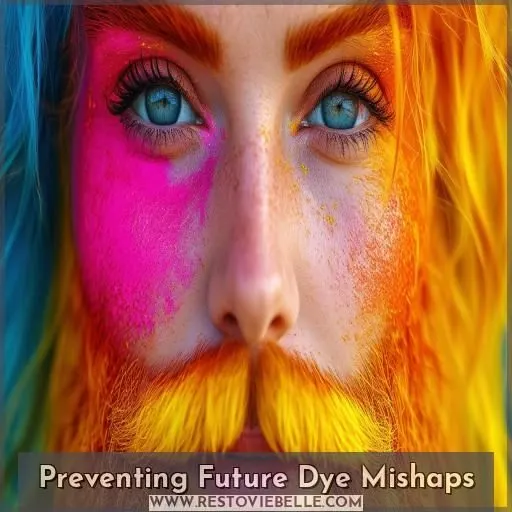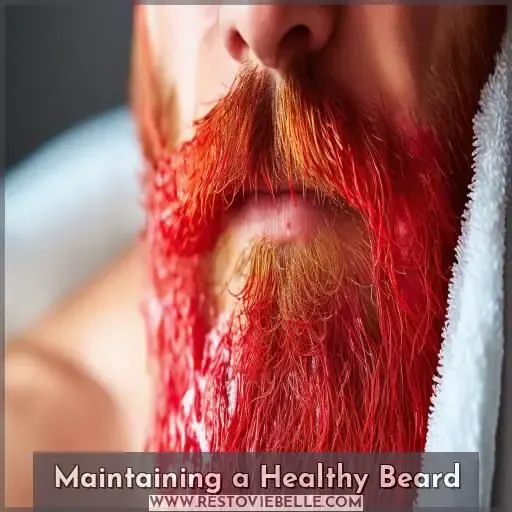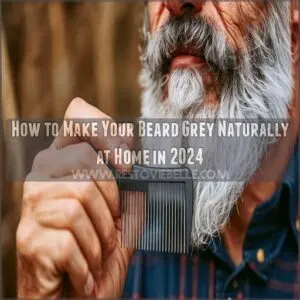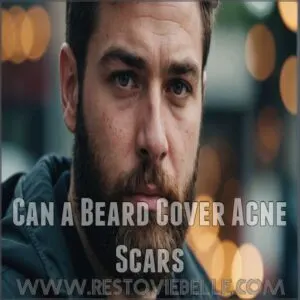This site is supported by our readers. We may earn a commission, at no cost to you, if you purchase through links.
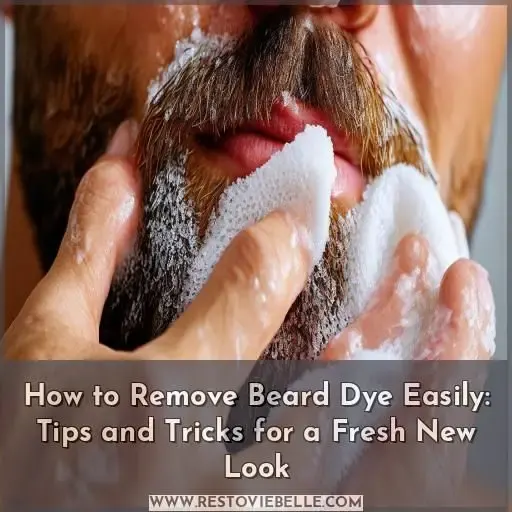 You’re not happy with how your beard dye turned out, and want to remove it easily, right?
You’re not happy with how your beard dye turned out, and want to remove it easily, right?
Don’t worry, you’ve got options!
baking soda and lemon juice are affordable home remedies that can help lift that unwanted color.
Mixing shampoo with vinegar or peroxide can also do the trick – just be gentle.
If you’d rather leave it to the pros, salons offer dye removal services for a fresh start.
Whatever route you choose, doing a patch test first is key to avoid irritation.
And if you’re ready to take the next step, there are tips for preventing future dye mishaps while keeping your beard healthy.
Table Of Contents
Key Takeaways
- Look no further than your humble pantry for affordable beard dye removal remedies, my friend! A little baking soda and lemon juice can work wonders in lifting those unwanted hues, saving you from a dire "beard fail" situation.
- If home remedies aren’t cutting the mustard, don’t be afraid to call in the big guns – a visit to the salon for professional dye removal services can be a game-changer. Those stylists have all the tricks up their sleeves to get your mane back in tip-top shape.
- An ounce of prevention is worth a pound of cure, as they say. To avoid future dye disasters, choose your products wisely and always do a patch test first – trust me, your face (and beard) will thank you!
- At the end of the day, a well-groomed beard is a happy beard. Show your facial hair some love with regular trims, moisturizing oils, and gentle, natural products. It’ll reward you with a luscious, healthy mane that’s the envy of all.
How to Remove Beard Dye?
To remove beard dye, try using baking soda mixed with shampoo or lemon juice in sunlight to gradually fade the color. You can also consult a professional stylist for salon treatments to safely remove stubborn beard dye.
Removing Beard Dye at Home
If you’re looking to remove beard dye at home, you have several options to try.
You could use baking soda, shampoo and conditioner, lemon juice and sunlight, hydrogen peroxide, or a combination of olive oil and dish soap.
Each method has its own advantages and potential drawbacks. It’s important to choose the one that suits your needs and hair type best.
Using Baking Soda
Baking soda, that pantry staple, is a cheap and effective way to remove beard dye.
Make a paste by mixing it with water until it reaches a spreadable consistency.
Gently massage it into your beard, letting it sit for 15-20 minutes before rinsing thoroughly.
Adjust the baking soda concentration for tougher stains.
It’s abrasive, so use sparingly to avoid drying out your facial hair.
Shampoo and Conditioner
If baking soda doesn’t work, try using a clarifying shampoo and conditioner. Here’s how:
- Mix equal parts shampoo and vinegar.
- Massage the mixture into your beard.
- Let it sit for 10-15 minutes.
- Rinse thoroughly with cool water.
The vinegar will help strip the dye, while the shampoo cleanses. Repeat as needed until the dye fades. For stubborn dye, try adding a bit of acetone to the mix.
Lemon Juice and Sunlight
If using a lemon juice and sunlight method, you’re harnessing citrus bleaching power to lift beard dye. Mix equal parts lemon juice and water, apply to your beard, then sit in the sun for an hour or two. Rinse thoroughly afterward. However, be cautious of potential skin irritation and sun damage.
| Pros | Cons | Notes |
|---|---|---|
| Natural ingredients | Lengthy process | Vitamin C aids bleaching |
| Sun exposure lifts dye | Potential burns from UV rays | Monitor beard closely |
| Affordable option | Inconsistent results | Patch test first |
Hydrogen Peroxide
Another option is using hydrogen peroxide. Just be careful, as it can:
- Irritate your skin
- Damage your beard hair
- Fade color too quickly
If you do try it:
- Dilute it with water
- Do a patch test first
- Leave it on for short periods
Hydrogen peroxide works quickly, but it’s harsh. Consider gentler alternatives if your beard is sensitive.
Olive Oil and Dish Soap
You can also try a combination of olive oil and dish soap. Olive oil helps loosen beard dye, while dish soap’s degreasing properties remove it effectively. First, massage olive oil into your beard, let it sit for 30 minutes, then shampoo with dish soap. Rinse thoroughly to prevent skin irritation.
Professional Beard Dye Removal
For stubborn beard dye that won’t budge with home remedies, you can seek professional salon treatments specifically designed for dye removal. Consulting with an experienced stylist is also advisable as they can assess your situation and recommend the safest, most effective methods for achieving your desired look.
Salon Treatments
If home remedies aren’t cutting it, consider professional salon treatments. They offer targeted solutions like:
- Color correction services
- Deep conditioning treatments
- Dye-removing products
Salon experts understand hair chemistry, ensuring dye removal is safe and effective. Plus, they can recommend products to prevent future mishaps and maintain your beard’s health.
Consulting a Professional Stylist
If home remedies fail, consulting a professional stylist is your best bet. Experienced stylists offer advanced techniques and products to remove stubborn dye safely. However, be prepared for higher consultation costs. A stylist’s expertise guarantees your beard’s health isn’t compromised during removal. Here’s what you can expect:
| Consultation | Process | Precautions | Cost Range | Results |
|---|---|---|---|---|
| 30-60 mins | Multi-step | Skin test | $50-$150 | Fresh look |
| In-depth analysis | Customized | Protective gear | Varies by location | Healthy beard |
Trust the pros for flawless beard dye removal and expert advice on maintaining your new look.
Preventing Future Dye Mishaps
To prevent future beard dye mishaps, choose a high-quality dye from a reputable brand and carefully follow the instructions provided. Before applying any new dye, perform a patch test on a small, inconspicuous area to check for any adverse reactions.
Choosing the Right Dye
Choosing the right beard dye prevents future mishaps. Consider:
- Your natural hair color
- The desired shade (lighter or darker)
- Temporary vs. permanent dye
- Reputable brand with quality ingredients
- Shade variations for even coverage
Guarantee the dye complements your skin tone and desired look. Test a small section first to guarantee it meets your expectations.
Following Instructions
Carefully following the instructions on your dye kit is essential for achieving the desired shade. Don’t get too impatient and skip steps – that’s a recipe for disaster! Read through everything before starting, and take your time with application. If you mess up, you might’ve to reach for those home remedies we covered earlier.
Performing a Patch Test
Before dyeing your beard, always perform a patch test.
Apply a small amount of the dye to an inconspicuous area and wait 48 hours to check for skin irritation or an allergic reaction.
This simple safety precaution can prevent disastrous dye mishaps, saving you from dealing with a dreaded "beard fail" situation.
Don’t skip this essential step – your face will thank you.
Maintaining a Healthy Beard
To maintain a healthy beard, regularly trim stray or unruly hairs to keep it looking neat and tidy. Additionally, use a quality beard oil or moisturizing conditioner to hydrate the hair and skin, preventing dryness, itchiness, and breakage.
Regular Trimming
Regular trimming is essential for a healthy beard. It keeps your facial hair looking neat and prevents split ends. Follow these steps: 1) Wash and dry your beard, 2) Use sharp scissors or trimmers, 3) Trim evenly, following your jaw’s natural line, and 4) Brush to remove loose hairs. Consistent trimming promotes thicker, healthier beard growth.
Moisturizing and Conditioning
Maintaining your beard’s hydration and nourishment is paramount. Employ a premium beard oil or balm to deeply moisturize and condition its sumptuous strands. This will preserve moisture, shield against external stressors, and maintain your mane’s silky smoothness. Avoid neglecting hydration – your beard will reward you with a healthy, radiant appearance.
Avoiding Harsh Chemicals
In addition to moisturizing, you’ll want to avoid harsh chemicals that can damage your beard. Here are some natural options to try:
- Apple cider vinegar rinse (balances pH)
- Aloe vera gel (soothes skin)
- Coconut oil (provides nourishment)
- Honey (antibacterial and humectant)
- Chamomile tea (anti-inflammatory)
Using gentle, natural products will keep your beard healthy and strong as it grows out after dye removal.
Common Mistakes to Avoid
One of the biggest mistakes to avoid when removing beard dye is over-dyeing, as this can lead to an uneven and patchy appearance. Another common error isn’t following the instructions carefully, which can result in incomplete dye removal or even damage to your beard.
Over-Dyeing
Over-dyeing your beard can lead to an uneven, unnatural appearance that’s difficult to correct. You risk ending up with darker or lighter patches that don’t blend seamlessly. If you’ve made this mistake, don’t panic – color correction techniques like removing layers and fading effects can help restore your desired shade and even tone.
Not Following Instructions
You don’t want to make the mistake of not following instructions when dyeing your beard. It can lead to:
- Uneven color application
- Skin irritation or allergic reactions
- Accidental over-dyeing
- Results that don’t match your desired shade
Always do a patch test first and carefully read the dye instructions. Your beard’s health and the final look depend on it.
Using Low-Quality Dye
Low-quality dye can lead to patchy results and uneven coverage, leaving you frustrated. Worse, it often contains harsh chemicals that can damage your beard. You’ll end up paying more in the long run when you have to remove and redo the dye job. Invest in quality products from reputable brands – your beard will thank you.
Frequently Asked Questions (FAQs)
Can beard dye cause skin irritation?
Yes, beard dye can cause skin irritation, especially if you have sensitive skin. Take precautions by doing a patch test first and following the instructions carefully to minimize risks.
How often should I dye my beard?
Good sir, don’t dye too often – every 4-6 weeks max. Your beard needs time to breathe, lest ye face irritation most foul! Patience and moderation are key for a healthy, vibrant mane.
What are the best beard dye brands?
Some top beard dye brands to explore include Just for Men, Godefroy, and Bigen. They offer reliable, long-lasting color and come in various natural shades to complement your look. Stick with trusted brands for the best results.
Will beard dye affect my hair color?
Yes, beard dye can stain your skin and hair around the beard area. To avoid unwanted coloring, apply a barrier cream or petroleum jelly before dyeing to protect your hair.
How long does beard dye typically last?
Beard dye typically lasts around 2-4 weeks before needing a touch-up. The duration depends on factors like beard growth rate, product used, and how well you follow the instructions. With proper application and care, you can maintain your desired look for a reasonable period.
Conclusion
Discolored, unsatisfactory beard dyes can dampen anyone’s spirits.
Yet, by following the right removal tips and techniques, getting that fresh, vibrant look is achievable.
Whether tackling it at home with baking soda and lemon, or relying on salon experts for professional how-to-remove beard dye services, a little care goes a long way.
Persevere through mishaps by learning from mistakes, and you’ll soon sport a beard you can be proud of.

